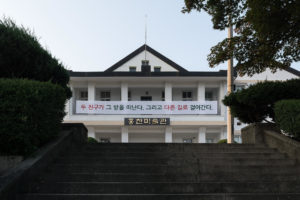Zwei Freunde verlassen den Raum und gehen in getrennte Richtungen
Two friends leave the room and walk in different directions
두 친구가 그 방을 떠난다. 그리고 다른 길로 걸어간다
(translated into Korean by Kyung-Ah Cho)
120 cm x 1150 cm
2017
Textile banner
“Two friends leave the room and walk in different directions” is a textile banner, which Thyra Schmidt created during her stay at the pink factory’s international residency program in Hongcheon, South Korea. The artwork was conceived in situ for the group exhibition Moving Shadow at the Hongcheon Art Museum in September 2017. Presented on the façade of the building, it stretched through the loggia of the entrance, contrasted by the museum’s sign below, with its golden letters on black ground.
On the white banner, there are Korean characters printed in red and green: the translation of the original German title. Thyra has chosen red for “Two friends” and “in different directions” and green for “leave the room and walk”. Due to the difference in grammar between Korean and German, there are two sentences in the translation. Also, the middle part of the original sentence is split, resulting in two red and two green parts. Furthermore, a one-to-one translation was not possible, but the artist discussed with the translator different options to find the most consistent transmission.
The regional street advertisements inspire the design, material and suspension of the banner. A number of these commercial signs cover entire façades. They indicate information about product offers or enterprise locations and are often multi-coloured. In Thyra’s work the red was chosen for its signalling effect and underlines – for her – the most important text parts. Green, being the complimentary colour to red, intensifies the radiating effect of its counterpart. Since images in the typical advertisement are unusual, the artist didn’t use them either. On the other hand, announcements of events and exhibitions are usually placed in special frames with a pre-specified format apart from buildings.
Thyra’s sentence contrasts with the commercial messages. For the Korean public, it had a more private or complex philosophical character. In particular, if perceived as a personal statement, the banner evoked astonishment, since it was located on a public building. Therefore, it was recognised as something private in a public space. Others, notably European viewers, saw a more politically-inspired reference. This might be evident with regard to the location in South Korea and its historical separation of North Korea.
Nevertheless, Thyra does not want to specify any interpretation. In the contrary, she hopes that “when read, an imaginary picture emerges – in the best case, many changing images. Images that evoke different associations. Images that allow complex interpretations.” (Artist’s statement)
At the same time, the artist deals with text also as image. The two different colours of the sub-sentences could symbolise as well the separation of the two friends given by the text content. Moreover, the full stop in the Korean translation splits the described actions: the quitting of the room and the division of the friends. A certain symmetry of the resulting image refers formally to the symmetry of the building.
Thyra Schmidt
Born in Pinneberg, Germany (1974) Thyra studied fine arts (painting and photography) at the University of Applied Sciences and Art in Hannover under Peter Tuma. After a guest residence at the Hiroshima City University (Japan) and studies at the University of Art (HBK) in Braunschweig under Dörte Eißfeldt, she went to the Kunstakademie (Academy of Fine Arts) Düsseldorf, Germany in the class of Thomas Ruff until 2005.
Together with other students of Thomas Ruff, she founded in 2003 the artist group FEHLSTELLE, who realises art-projects in public space. Thyra’s individual works are sometimes also situated in public space like “I can’t just be nowhere” in cooperation with the Goethe-Institute in Oslo, Norway and “Staccato” for the Kunstverein (Art Association) Paderborn, Germany. At the same time, her works are shown in numerous individual and group exhibitions in Germany and abroad such as France, Italy, Brazil and South Korea.
Besides photography, Thyra started already in 2007 to experiment with scripture. For her participation at the “Congress of Futurologists” in Eisenhüttenstadt, Germany, she asked people to write words or small sentences on paper provided by her. Since this time, she reflected about the image that is formed by writings. For “I can’t just be nowhere” in Oslo she combined text and photo. The texts were quotes by different authors, partly modified by her.
Progressively, Thyra evolved from her initially mostly photo-based works to text dominated. In her solo exhibition in 2015 “Blaue T-Shirts, Jeans und Turnschuhe” (Blue T-Shirts, Jeans and Trainers) at Martin Leyer-Pritzkow, Düsseldorf, there were seven texts and only two photos. As supplement to the exhibition, the artist published in 2017 a small book including new works of the series from 2016. Here there are five photos and thirteen texts, all by herself.
The arrangement of the words indicates how the sentence should be read, with breaks for dwell time. Moreover, these texts can be received as abstract pictures, especially for non-German speakers and particularly for people who cannot read Latin letters.
During her this year’s artist residence in Hongcheon, South Korea, Thyra created a new work, once again a text. Since it was exposed at the façade of the Hongcheon Art Museum, it was translated into Korean. For the average western onlooker, who cannot read the letters the abstraction is evident. 두 친구가 그 방을 떠난다. 그리고 다른 길로 걸어간다 (Two friends leave the room and walk in different directions) is our artwork of the month of October 2017.

